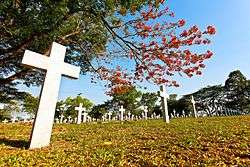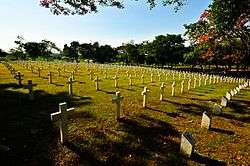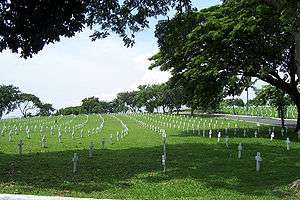Heroes' Cemetery
| Heroes' Cemetery Libingan ng mga Bayani | |
|---|---|
| Taguig, Metro Manila, Philippines | |
|
Heroes' Cemetery | |
| Used for those deceased | |
| Established | May 1947 (as Republic Memorial Cemetery) |
| Location |
14°31′12″N 121°02′38″E / 14.520°N 121.044°E Bayani Road, Taguig, Philippines |
Heroes' Cemetery, officially known as Libingan ng mga Bayani (LNMB), is a national cemetery within Fort Bonifacio (formerly Fort William McKinley) in Western Bicutan, Taguig, Metro Manila, Philippines.
First established in May 1947 as a fitting resting place for Filipino military personnel from privates to generals who served during World War II, it eventually became designated as the official place of burial for deceased Philippine Presidents, national heroes, patriots, National Artists and National Scientists.
Among those buried in the cemetery are Filipino soldiers who died during the Philippine Campaign and the Allied Liberation of the Philippines in World War II from 1941 to 1945. Among the Filipino leaders and dignitaries buried there are Presidents Elpidio Quirino, Carlos P. Garcia and Diosdado Macapagal; former Vice-president Salvador H. Laurel; generals Artemio Ricarte and Carlos P. Romulo; Armed Forces of the Philippines (AFP) Chief of Staff Angelo Reyes; and former Senate President and proclaimed Vice President Arturo Tolentino and Blas Ople. Former president and exile Ferdinand Edralin Marcos is the most recent president to be buried there, after the Supreme Court of the Philippines dismissed petitions against his burial on 8 November 2016.[1] [2] He was buried in a private ceremony, with military honors, on November 18, 2016,[3] amid much controversy resulting in nationwide protests.[4][5]
History

The cemetery was first established in May 1947 as the Republic Memorial Cemetery. It was first established as a tribute and final resting place for the 33,520 Filipino soldiers who died during the Philippine Campaign (1941–42) and the Allied Liberation of the Philippines (1944-45) in World War II.[6][7] It was established as the Filipino counterpart to the Manila American Cemetery and Memorial, which houses the remains of United States personnel who died during the same war.[8]
On 16 June 1948, Philippine President Elpidio Quirino signed into law the Republic Act 289, also known as An Act Providing for the Construction of a National Pantheon for Presidents of the Philippines, National Heroes, and Patriots of the Country.[9] Section 1 of the Act cites the purpose of creating such pantheon:
"To perpetuate the memory of all the Presidents of the Philippines, national heroes and patriots for the inspiration and emulation of this generation and of generations still unborn..."[9]
While such National Pantheon was never established during Quirino's lifetime,[10] several decrees and laws passed under succeeding administrations led to the eventual use of the Republic Memorial Cemetery as a national pantheon described in Republic Act 289.
On 27 October 1954, President Ramon Magsaysay renamed the Republic Memorial Cemetery as the Libingan ng mga Bayani.[6] On 28 May 1967, President Ferdinand Marcos issued Presidential Proclamation No. 208 ordering the reservation of 142 hectares of land within Fort Bonifacio in consideration for the Libingan to serve not only as a cemetery for military personnel but also as a national shrine for fallen heroes. He ordered it placed under the administration of the Military Shrines Services of the Philippine Veterans Affairs Office, an agency under the Department of National Defense.[6][11]
On 9 April 1986, Armed Forces of the Philippines Chief of Staff Fidel Ramos and President Corazon Aquino issued Armed Forces Regulations G 161-373, also known as "The allocation of Cemetery Plots at the LNMB". This military-issued regulation established the internment policy that would become the basis for the burial of personalities at the Libingan ng mga Bayani.[12][13][14] Moreover, by virtue of Executive Order No. 131 issued by former President Fidel Ramos on 26 October 1993, National Artists and National Scientists of the Philippines were also made eligible for interment at the cemetery.[15]
In 2007, due to overcrowding at the Fort Bonifacio site, the cemetery's administration started exploring sites for Libingan ng mga Bayani annexes in Luzon, Visayas and Mindanao. Only one has been completed so far, the ₱24-million, five-hectare extension at Camp Hernandez in Dingle, Iloilo.[16]
Administration
The cemetery is administered and maintained by the Grave Service Unit (GSU), a unit of the Philippine Army Support Command of the AFP. Its mission is to provide burial and niche services to deceased military personnel and other personalities interred at the cemetery. Aside from maintaining the cemetery and the military grave site at Manila North Cemetery, the unit is also capable of providing mortuary and memorial services to authorized personnel.[6][16]
Interment policy
According to Armed Forces of the Philippines (AFP) Regulation G 161-373, the following persons are entitled to interment at Heroes' Cemetery:[10][13][14]
- Medal of Valor awardees
- Presidents or Commanders-in-Chief, AFP
- The secretaries of National Defense
- AFP Chiefs of Staff
- General/Flag Officers
- Active and retired military personnel of the AFP
- Former AFP members who laterally entered/joined the Philippine National Police (PNP) and the Philippine Coast Guard (PCG)
- Veterans of the Philippine Revolution of 1896, the First and Second World Wars, as well as recognized guerrillas
- Government dignitaries, statesmen, national artists and other deceased persons whose interment has been approved by the commander-in-chief, Congress or the Secretary of National Defense, and
- Former Presidents, Secretaries of National Defense, widows of former Presidents, Secretaries of National Defense and Chiefs of Staff
- National Artists and National Scientists of the Philippines[15]
However, the same regulation also prohibits “personnel who were dishonorably separated/ reverted/ discharged from the service and personnel who were convicted by final judgment of an offense involving moral turpitude” from interment at the Heroes' Cemetery.[10][13][14]
Features

The first structure that visitors will see upon entering the grounds of the cemetery complex is the Heroes Memorial Gate, a large concrete tripod with a stairway leading to an upper view deck with a metal sculpture at the center.[6] Erected on opposite sides of the main entrance road near the Heroes Memorial Gate are two 12-foot high black stone walls which bear the words that General Douglas MacArthur uttered during a journey to the Philippines in 1961: "I do not know the dignity of his birth, but I do know the glory of his death."[6]
The main structure, located at the center of the cemetery, is the Tomb of the Unknown Soldier, where wreath laying ceremonies are held when Philippine government officials and foreign dignitaries visit the cemetery. Inscripted on the tomb are the words: "Here lies a Filipino soldier whose name is known only to God." Behind the tomb are three marble pillars representing the three main island groups in the Philippines: Luzon, Visayas, and Mindanao.[6]
There are several pylons as well commemorating the gallantry of Filipino soldiers who died in various wars in world history. These include the Korean Memorial Pylon, which honors 112 Filipino officers and men who were members of the Philippine Expeditionary Forces to Korea (PEFTOK) who perished during the Korean War; the Vietnam Veterans Memorial Pylon, which was dedicated to the members of the Philippine contingent and Philippine civic action groups (PHILCON-V and PHILCAG-V) that were sent to Vietnam during the Vietnam War from 1964 to 1971; and the Philippine World War II Guerrillas Pylon, which was erected by the Veterans Federation of the Philippines as a testimony to the indomitable spirit and bravery of the Filipino guerrillas of World War II.[6]
Notable burials
- Elpidio Quirino, 6th President[17]
- Carlos P. Garcia, 8th President[17]
- Diosdado Macapagal, 9th President[17]
- Ferdinand Marcos, 10th President[3]
- Arturo Tolentino, former Secretary of Foreign Affairs and Senator
- Salvador H. Laurel, 10th Vice President
- Artemio Ricarte, Philippine Revolutionary Army Chief of Staff
- Carlos P. Romulo, Secretary of Foreign Affairs and Senator
- Angelo Reyes, Armed Forces of the Philippines Chief of Staff
- Blas Ople, Secretary of Foreign Affairs and Senator
- Fe Del Mundo, a Philippine pediatrician whose studies led to the improvement of the neonatal incubator
See also
References
- ↑ "Supreme Court allows burial of Marcos at Heroes' Cemetery". CNN Philippines. November 8, 2016.
- ↑ "Philippine dictator Marcos given hero's burial". Bangkok Post. November 18, 2016.
- 1 2 "Armed Forces: Instruction was to keep Marcos burial a secret". The Philippine Star. November 18, 2016.
- ↑ "Protesters take to streets to denounce Marcos 'Libingan' burial".
- ↑ "LIVE updates: Protests after Ferdinand Marcos' burial". philstar.com. Retrieved 2016-11-19.
- 1 2 3 4 5 6 7 8 La Putt, Juny. "Libingan ng mga Bayani (Cemetery of the Heroes)". CorregidorIsland.com. Retrieved 16 August 2016.
- ↑ "Libingan ng mga Bayani". Taguig Landmarks. City Government of Taguig. Retrieved 16 August 2016.
- ↑ Rodell, Paul A. (2002). Culture and customs of the Philippines. Greenwood Publishing Group. p. 93. ISBN 0-313-30415-7. Retrieved 16 June 2009.
- 1 2 "Republic Act No. 289-An Act Providing for the Construction of a National Pantheon for Presidents of the Philippines, National Heroes, and Patriots of the Country". Chan Robles Virtual Law Library. Retrieved 1 July 2011.
- 1 2 3 "Why not Libingan ng mga Pangulo instead?". ABS-CBN News. Retrieved 16 August 2016.
- ↑ "Libingan ng mga Bayani". Our Heritage and the Departed: A Cemeteries Tour. Presidential Museum and Library. Retrieved 16 August 2016.
- ↑ "Quick facts about the Presidency". Presidential Museum and Library. Retrieved 16 August 2016.
- 1 2 3 D. Pascual Jr., Federico (23 April 2011). "Trudging back to old haunts and bad habits". The Philippine Star. Retrieved 7 August 2013.
- 1 2 3 Elena, Aben (27 May 2016). "AFP explains rules for 'Libingan ng mga Bayani'". The Manila Bulletin. Retrieved 16 August 2016.
- 1 2 "Executive Order No. 131 - Facilitating the State Funeral of Deceased National Artists and National Scientists". The Official Gazette of the Republic of the Philippines. 26 October 1993.
- 1 2 Dizon, Nikko (4 November 2007). "Burial space for soldiers running out". Philippine Daily Inquirer. Retrieved 16 August 2016.
- 1 2 3 Dizon, Jaymee T. Gamil, Nikko. "After 60 years, President Quirino gets burial he deserves". Philippine Daily Inquirer. Retrieved 19 November 2016.
External links
 Media related to Heroes' Cemetery at Wikimedia Commons
Media related to Heroes' Cemetery at Wikimedia Commons- "Libingan ng mga Bayani (Cemetery of the Heroes)". Find A Grave. Retrieved 16 June 2009. (coordinates)

